The biggest spiders in the world – Top 10
Many people are terrified of spiders and others find them simply fascinating. Spiders are found worldwide on every continent except for Antarctica. They live everywhere with the exceptions of air and sea. Spiders have eight legs and chelicerae with fangs that inject venom. Over 48 thousand species of spiders have been described so far. Have you ever wondered what the biggest spider in the world looks like? In this article, you will find out. Let’s get to know the largest spiders in the world.
Characteristics of the
14 largest spiders in the world

14. Tegenaria parietina – 14 cm (5.5 in)
The wall angle spider or house spider reaches a body length up to 2 cm (0.79in), males up to 1.7 cm (0.67in) with legs up to three times as long. The leg span between the rear and front legs can be up to 14 cm (5.5 in). The females are up to 8 years old and the males usually die shortly after mating. They live in houses in quiet places and on old walls. In the open air, the spiders live in crevices, under rocks and loose bark of dead trees. The species is predominantly found in southern Europe.
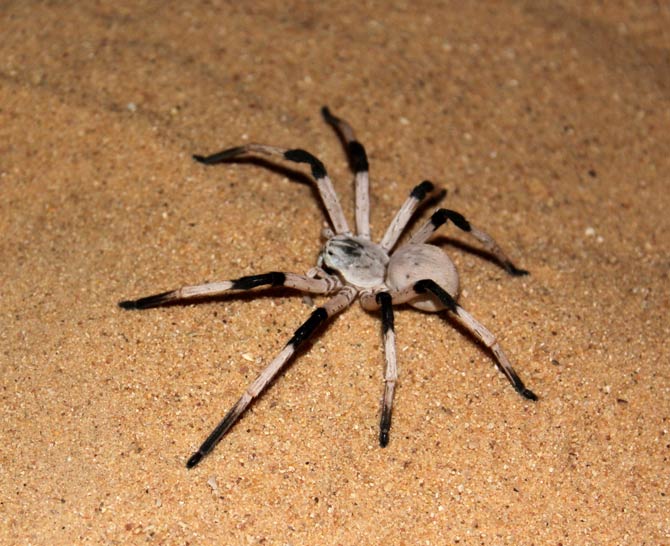
13. Cerbalus aravaensis (huntsman spider) – 14 cm (5.5 in)
This spider was discovered in 2003 in the sand dunes of the Arava in southern Israel and Jordan. The females grow up to about 2.65 cm long (2.20–2.65 cm (0.87–1.04 in)), the males remain a little smaller (1.85–2.40 centimeters (0.73–0.94 in)). Together with its legs it reaches a size of about 14 cm (5.5 in) and is the largest giant crab spider in the Middle East.
The females grow up to around 2.65 cm (1.04 in) long, the males remain slightly smaller. The carapace is sand-colored, light gray to yellowish, and densely covered with fine bristles. A dark brown band extends dorsally across the middle of the carapace and ends in front at the tips of the chelicerae. The abdomen is uniformly cream-colored and has no special markings. The strikingly strong legs can be used for digging in the sand. They have the same basic color as the carapace, but are black at the joints and tips. The front middle eyes are the largest, the back the smallest. The clypeus, between the front pair of eyes and the edge of the carapace, is very narrow.
Cerbalus aravaensis lives in a hot, arid climate. Nevertheless, the spiders are mainly active in summer. During the hottest months of the year in their area of distribution, in July and August, it is mainly the males that migrate. The spiders are nocturnal and live in underground caves during the day, which is closed with a kind of trap door made of sand glued together with spider silk.
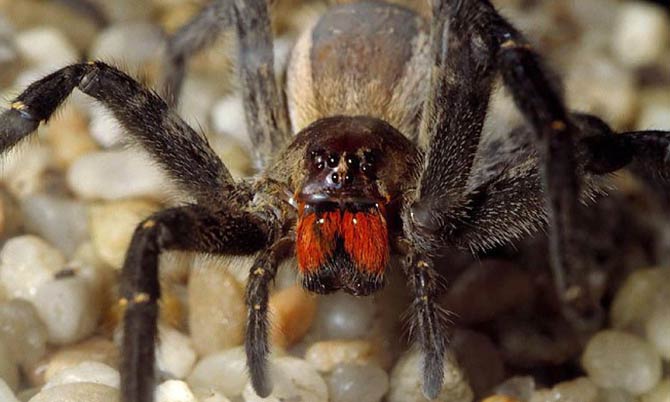
12. Brazilian wandering (Phoneutria) – 15 cm (5.9 in)
The Brazilian wandering spider or banana spider is considered to be very aggressive and highly poisonous. The females reach a body length of 3 to 5 cm and a leg span of 13 to 15 cm (5.1 to 5.9 in). The males are slightly smaller. Instead of lurking on the prey as most spiders do, these spiders go hunting at night. During the day they hide in dark, humid places, often in human dwellings. You’ve probably heard of highly poisonous spiders in imported fruit crates in the media. Other names: armed spider, banana spider.
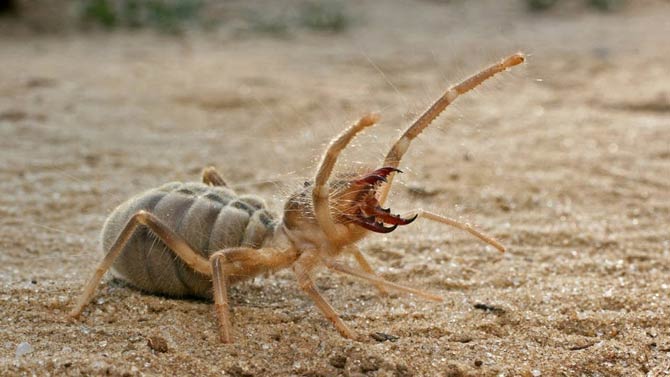
11. Camel spider – 15 cm (5.9 in)
The body length is up to 7 cm (3 in). Legs span of 12–15 cm (5–6 in). Other names: wind scorpion, sun spider, solifuge. These spiders (Solifugae, also Solpugida) form an order of the arachnids (Arachnida), which includes over 900 species. Contrary to what the name might suggest, these non-toxic spiders are not “real” spiders. The largest camel spiders can measure up to 70 mm (3 in) from head to abdomen, but most species are much smaller. The camel spiders mostly live in arid areas, especially in deserts and steppes. Some species can be found in the Mediterranean area. Most species are active at night or at dusk and spend most of the day in self-dug tubes under stones.
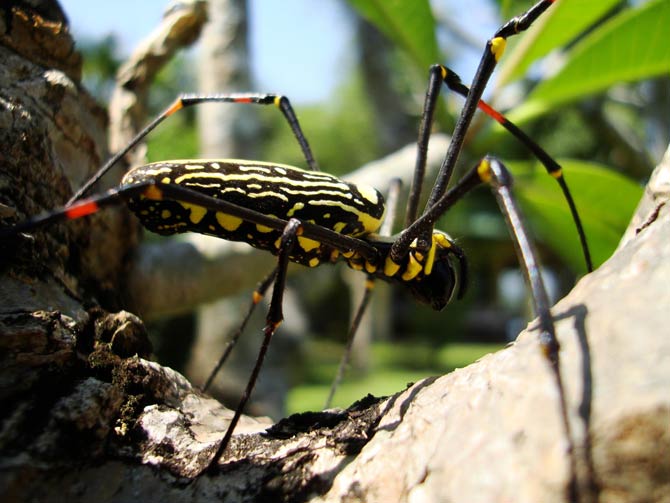
10. Golden silk orb-weavers (Nephila) – 15 cm (5.9 in)
The length of the silk spiders can be up to 6,9 cm (2.7 in) depending on the species and the leg span can be up to 15 cm. Females typically are 4.8–5.1 cm (1.5–2 in) and males less than 2.5 cm, (1 in). Their habitat is restricted to the tropics and subtropics. A 165 million-year-old female specimen of a silk spider was found in China. The silk spider Nephila jurassica has a leg span of 15 cm (5.9 in)and is thus one of the largest fossil spiders discovered so far. Other names: golden orb-weaver, giant wood spider, banana spider.
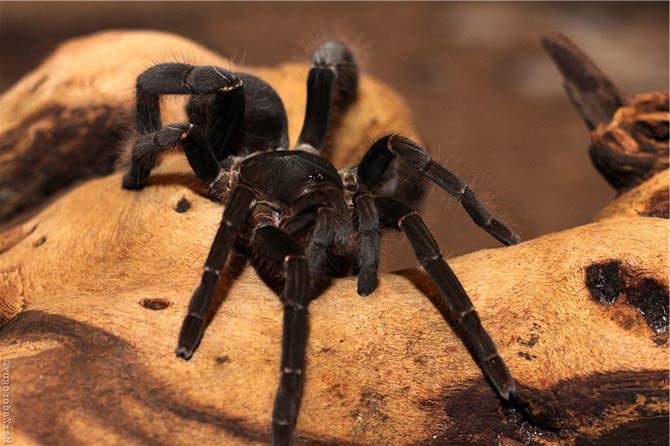
9. Giant baboon spider (Hysterocrates gigas) – 20 cm (8 in)
The Hysterocrates gigas is one of the tarantulas and lives in Cameroon. It lives in tropical wooded areas with high humidity in the ground. It is a relatively large tarantula and reaches a body length of about 8 to 10 cm (up to 4 in). The female’s leg span is up to 20 cm. males – up to 13 cm (5 in). Another name: Cameroon red baboon spider.
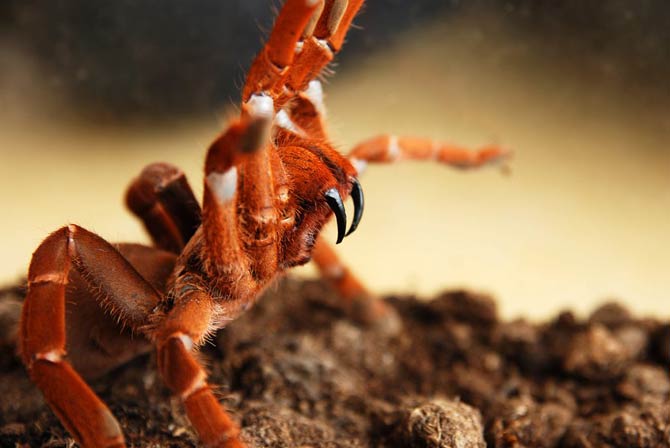
8. King baboon spider (Pelinobius muticus) – 20 cm (8 in)
This rare spider is a tarantula native to East Africa. It reaches a body length of 10 -13 cm (3.9 – 5.1 in). The leg span is also about 20 cm (8 in). The color of the spider varies from reddish-brown to golden brown. At the slightest disturbance, she goes into a threatening position and strikes with her legs. Not infrequently it bites too.
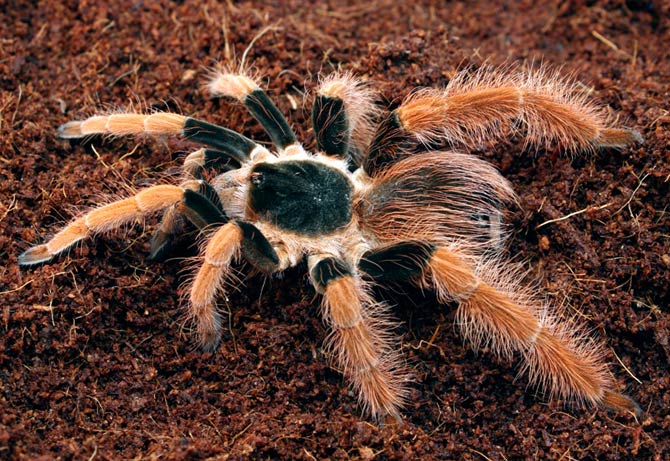
7. Colombian giant tarantula (Megaphobema robustum) – 20 cm (8 in)
Megaphobema robustum is also known as the Colombian giant tarantula or Colombian giant redleg has a span of 6 to 8 inches. This spider can be found in the tropical rainforests of Colombia and Brazil near logs. The spider eats crickets, other large insects, small lizards and various mice. It is known for its defensive behavior. Another name: Colombian giant redleg.
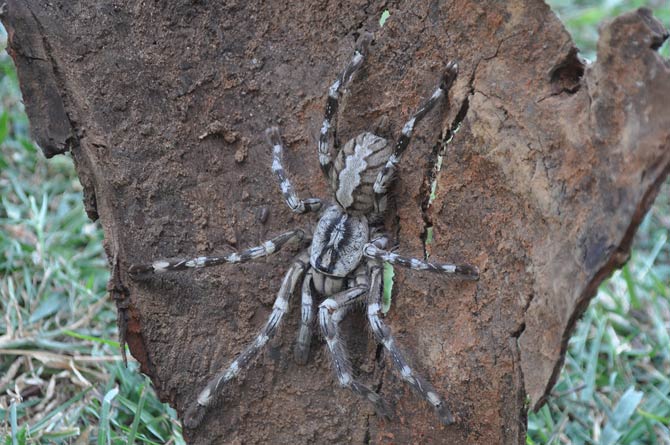
6. Poecilotheria Rajaei – 20 cm (8 in)
This spider has a leg span of up to 20 centimeters (8 in), has vivid yellow and gray piping on the first and fourth legs with a pink abdominal band. It prefers to live in old-growth trees, but is considered rare due to deforestation in its war-torn habitat and has taken to living in old buildings. The venom of P. rajaei is not lethal to humans but can kill small rodents, birds, lizards and snakes.
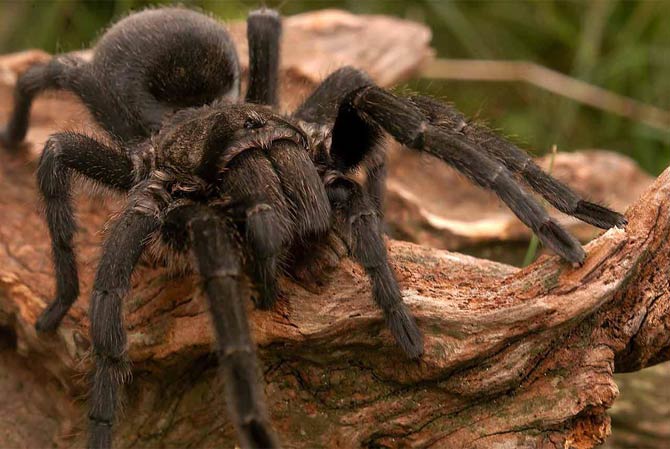
5. Brazilian Giant Tawny Red Tarantula (Grammostola mollicoma) – 26 cm (10.2 in)
These spiders are medium to large in size and usually brown in color, with pinkish or orangish-red hairs. Grammostola mollicoma (or Grammostola pulchra) is a species of mygalomorphs spider of the Theraphosidae family.
It is a large tarantula whose body is generally between 5 and 8 cm without counting the legs and is thickly covered with black hairs. It is a not very aggressive tarantula, although the males tend to be more aggressive than the females. It is a very long-lived type of tarantula, with some females living up to 30 years in captivity.
It is exclusive to South America and can be found in Uruguay, Brazil, Argentina, Chile and Paraguay, although the places with the highest number are in the north of Uruguay and south of Brazil. He lives in the mountains, where he makes caves under the stones.
The males, somewhat smaller than the females, feed on crickets, grasshoppers, cockroaches, worms, etc. The older females feed on any type of insect, small reptiles and voles.
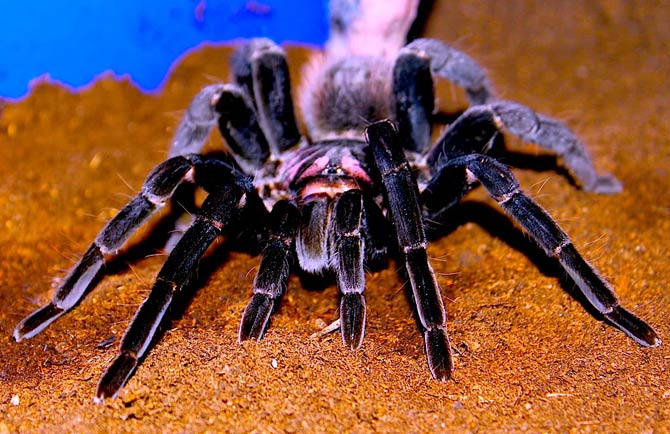
4. Xenesthis immanis – 22 cm (8.7in)
The following spider lives in rainforest areas in self-made caves. It reaches a body length of 6 to 7 cm (2.4 – 2.8 in) with a leg span of about 17 to 22 cm (6.7 – 8.7 in). In case of danger, she can use her irritant hairs. Irritable hairs can cause itching and burning of the skin and respiratory tract. It can also bite hard. The poison bite itself is not as dangerous as the infection by bacteria. Therefore, the wound must be disinfected immediately.
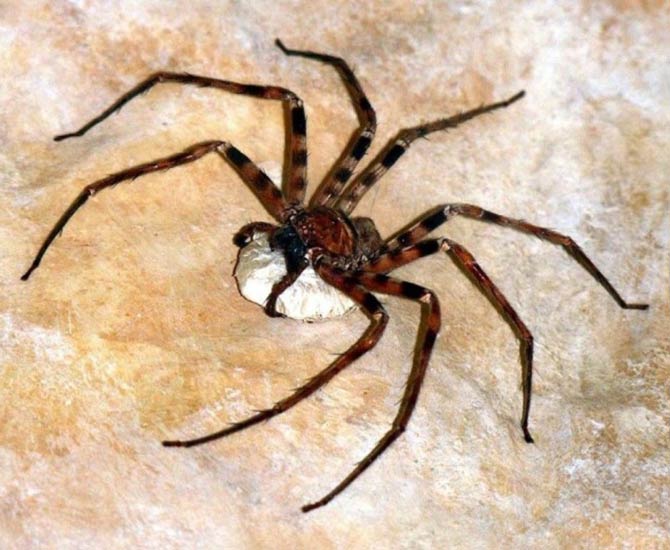
3. Giant huntsman spider (Heteropoda maxima) – 30 cm (12 in)
The main distribution area of Heteropoda maxima is located in the tropics and subtropics of Laos. It does not build a net, but lurks for its prey. It feeds on insects and other invertebrates. The booty animal is grabbed with the four front legs and poison is injected with the poison claws. The killed booty is then sucked out. The Heteropoda maxima is very large in relation to the maximum leg span of 30 cm (12 in). But the body is relatively small with a maximum of 4.6 cm 1.8in. This is why the Heteropoda maxima ranks third among the largest spiders.
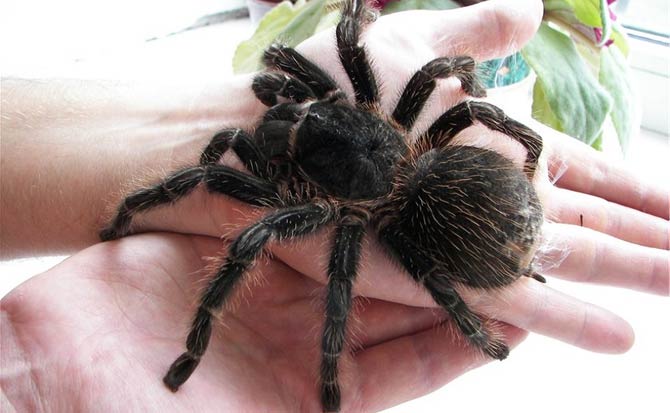
2. Brazilian salmon pink bird-eating tarantula (Lasiodora parahybana) – 27.8 cm (11 in)
This tarantula also has a maximum leg span of 28 cm. But thanks to a length of 9-10 cm it occupies the 2nd place of the biggest spiders in the world. The spider has a shaggy appearance with long and dense hair. It has a black basic color, which is a little bit greyish. It lives in dry forests and steppes in Eastern Brazil. If it produces cocoons, they contain up to 2000 eggs. However, the newly hatched young animals are usually very small compared to other tarantulas. Females can weigh more than 100 grams.
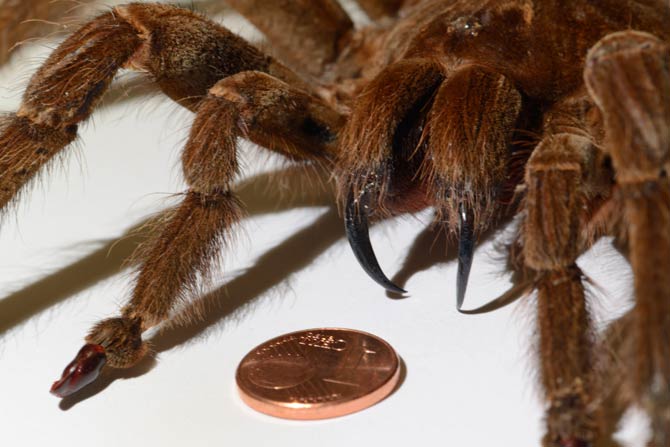
1. Goliath birdeater (Theraphosa blondi) – 28 cm (11 in)
The biggest spider in the world. With a body length of up to 11.9 cm (4.7 in) and a leg span of up to 28 cm (11 in) cm, the Goliath tarantula has made it to first place. It is very hairy and its color is rust-brown to chestnut brown. Females can reach a weight of up to 175 grams. The biting claws of the giant tarantula reach a length of approx. 2.5 centimeters. The abdomen can reach the size of a tennis ball in captivity with excessive feeding. These spiders live in the tropical rainforest of South America, northern Brazil, Surinam and French Guiana. It is also called the Goliath bird-eating spider. Females have a lifespan of 15 to 25 years. Males die soon after maturity and have a lifespan of 3 to 6 years.
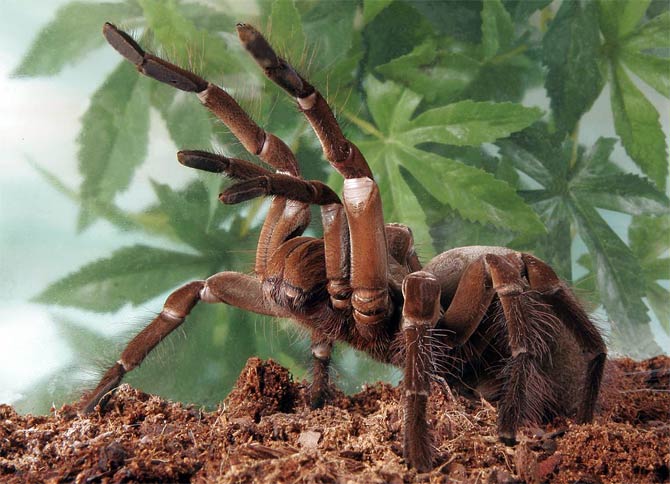
Recommended
- Fastest animals – Top 100
- Fastest animals – on land, in water and in the air
- Fastest mammals
- Fastest birds
- Cheetah
- Most venomous snakes – Top 10
- Largest eagles – Top 10
- Largest birds of prey
- Smartest dogs – Top 10
- Animals records
- Largest crocodiles
- Longest whales
- Heaviest whales
- Longest snakes
- Most venomous snakes
- Largest sharks
- Top-flying birds
- Heaviest dinosaurs
- Longest dinosaurs



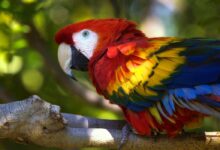






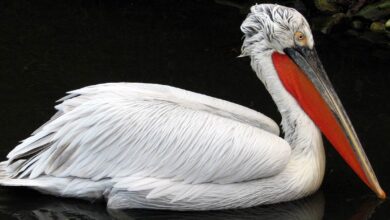






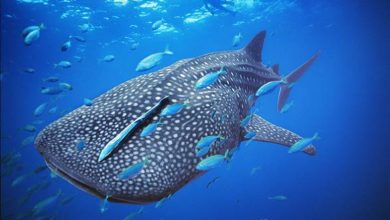
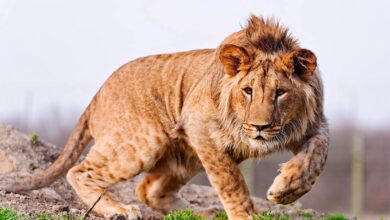
I found this web page very interesting. Thank you.
Thank you :)!